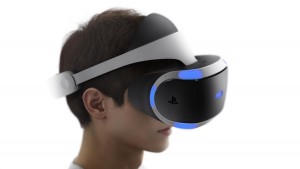 Virtual reality is about to officially become The Next Big Thing™, and thus far the reception from those who have tried it for themselves has been overwhelmingly positive. For the five of you who are still unaware of the technology, VR headsets are basically small monitors designed to be worn over your eyes which correspond to the movement of your head. By showing you a highly detailed three-dimensional image, the headset creates the illusion that you’re somewhere else – in a virtual reality. Naturally, everyone and their mother trying their hands at building a VR headset and jump in on the bandwagon. From Sony through Google to Facebook, there’s dozens of these highly expensive pieces of immersive technology, so many that it can get a bit confusing. Huge, detailed guides have been made to help navigate the average consumer through the market, but I’m going to try something a bit smaller and try to give a basic rundown of each major headset in 300 words or so.
Virtual reality is about to officially become The Next Big Thing™, and thus far the reception from those who have tried it for themselves has been overwhelmingly positive. For the five of you who are still unaware of the technology, VR headsets are basically small monitors designed to be worn over your eyes which correspond to the movement of your head. By showing you a highly detailed three-dimensional image, the headset creates the illusion that you’re somewhere else – in a virtual reality. Naturally, everyone and their mother trying their hands at building a VR headset and jump in on the bandwagon. From Sony through Google to Facebook, there’s dozens of these highly expensive pieces of immersive technology, so many that it can get a bit confusing. Huge, detailed guides have been made to help navigate the average consumer through the market, but I’m going to try something a bit smaller and try to give a basic rundown of each major headset in 300 words or so.
Let’s start with the obvious one – PlayStation VR. It’s going to be a very high-quality headset which is also going to be utilizing existing PlayStation technology to keep the cost relatively low (we’re expecting a price point of about $300-$400 as opposed to the $600 of other headsets). It’s definitely going to be one of the best VR headsets out there, but the downside is that it’ll only work with the PlayStation 4 and will require the PS Camera. Now, the PS4 is a very solid console, probably the best of this generation, so it’s definitely worth the investment if you’re a gamer, but if you’re not you’re probably better off going with another headset. I’d personally write Google Cardboard off entirely. While it’s by far the cheapest headset out there, costing only a few dollars, it’s not one designed to be used for more than a few minutes, and is overall little more than a novelty. The Samsung Gear VR is slightly better, but it still requires that you use your phone, and as such you won’t get the optimal high fidelity when it comes to both the screen and the processing power that you’d get from other headsets.
That leaves us with only 2 major options – the HTC Vive and the Oculus Rift, which kick-started the entire fad. Now, the Oculus is definitely the best option, as under the leadership of Facebook its creators at Oculus have spared no expense in making it the absolute best it could possibly be. However, that perfection comes at a price – $600 for the headset and $1500 for a computer powerful enough to support it. The Vive is more expensive than the basic Rift unit – at $800, but it also comes with two motion controllers you can use for maximum immersion, and also requires a less powerful (and thus less expensive PC) in order to work properly.
That’s pretty much it, really. While there are more options being developed, such as Valve’s own VR headset, the five I outlined are the most prominent sets that you can purchase starting later this year. Keep in mind that I’m excluding augmented reality headsets and glasses from this list, such as Microsoft’s HoloLens – we’ll save those for another time. I hope this rundown has been useful, and I’ll see you in the virtual reality!
